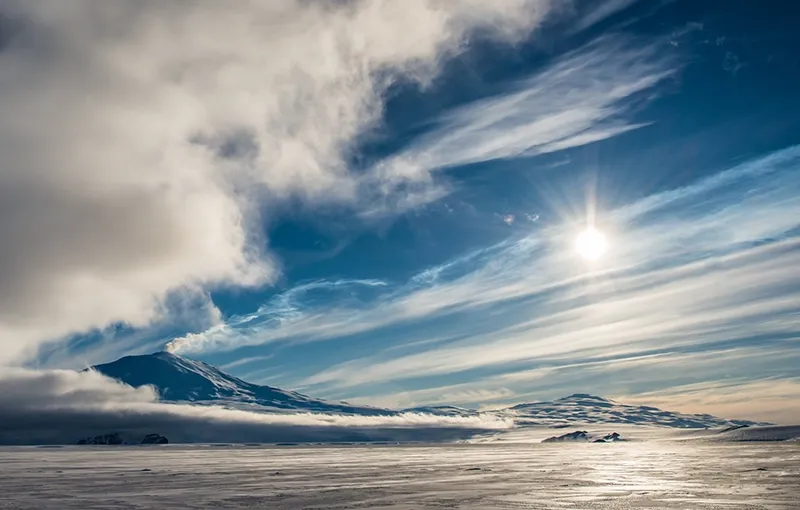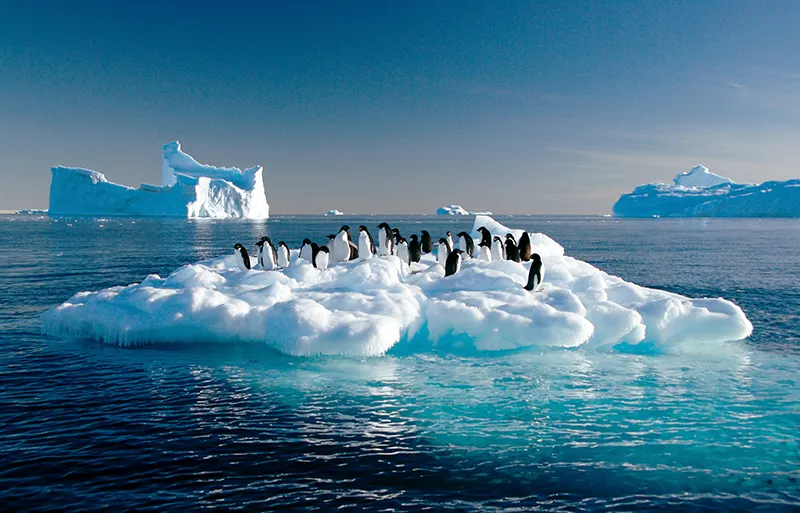As the sailing ships Erebus and Terror approached the solid strip of ice, the members of the expedition saw a tall white cone far to the south, over which clouds of smoke were rising. Captain James Ross was sure he had found Antarctica, but it was still only a volcanic island.
Antarctica’s southernmost and most active volcano
Erebus is the second highest and most active volcano in Antarctica. Higher is only an extinct Sidley (4285 m) on Mary Baird Land.
Erebus is not located on the continental part of Antarctica, but on the large (2460 km2) Ross Island, and it is not the only volcano on it. The island is generally lucky with volcanoes: in addition to Erebus there is extinct shield Terror (3230 m) about a million years old and a couple of lower volcanoes – Terra Nova (2130 m) and Bird (1765 m).
Erebus volcano is an intraplate volcano and belongs to the McMurdo volcanic group, part of the West Antarctic Rift System. Magma beneath Erebus rises from the upper mantle at a rate of about 6 cm/year.
The base of the volcano is made up of volcanic rocks: basalt, trachyte, phonolite and tuff. From above they are covered by glaciers that descend to the ocean. The largest tongue is 50 to 300 meters thick. Approaching the shore, it sinks into the water and stays on its surface: in this place it is quite deep. In summer, the ice melts and the broken off parts of the glacier form icebergs. Waves also break through the caves in the glacier, where the temperature stays around 0°C, and humidity is 100%, which contributes to the formation of huge icicles, similar to stalactites, and large ice crystals.
The most famous of these ice cavities has earned its own name – Warren Cave, created by vapors from the volcano. Its bottom is wet, soft soil and rocks, and its walls are ice. Explorers tell us that it is pitch-black in the depths, and when they turn on flashlights, the black walls turn into a multicolored kaleidoscope of flying sparks.
The crater of the volcano is a caldera about a kilometer in diameter, which are constantly acting fumaroles and geysers. At its bottom is a smaller crater about a kilometer deep, and in it is a lake of molten lava. Erebus is one of several volcanoes on Earth whose lake of molten kenite (a type of phonolite) has existed for quite a long time – several decades. Erebus is the only active volcano on Earth, spewing kenite magma at a temperature of +900°C, this rock in a solid state is also found in the mountains of Kenya (hence the name).
The underground source of magma that feeds it into the crater of Erebus volcano was common to all other volcanoes on the island, now extinct. It is a lake of magma up to 300 km in diameter at a depth of about 200 km. Below it takes the form of a vertical channel descending to a depth of up to 400 km.
Erebus is referred to the “Strombolian” type of eruption, named after a volcano in the Tyrrhenian Sea. This means that the sluggish eruption lasts continuously, the volcano maintains a constant readiness for a stronger, but shorter eruption. The last one was observed in 2011.
During eruptions, clouds of steam are observed, accompanied by rare emissions of ash and volcanic bombs up to 10 meters in diameter, which fall around Erebus within a radius of one and a half kilometers. At eruption moments the gushing geysers also show themselves. Lava is ejected from the lake or from one of several holes within the inner crater of the volcano, but the lava remains inside the caldera and does not spurt out of it.
Erebus is located at the intersection of crustal faults, from which, according to volcanologists, there are periodic massive outbursts of deep gases, including hydrogen and methane. Reaching the stratosphere, they destroy the ozone layer, which is why its minimum thickness is observed above the Ross Sea, where volcano Erebus is located.
These bright natural cataclysms look very picturesque against the background of the ice shell of Antarctica. And do not scare a colony of half a million Adelie penguins living on the ice of Ross Island.
Careful study of the unique volcano is facilitated by its relative proximity to the main Antarctic research stations of the USA (McMurdo) and New Zealand (Scott Base), which are about 35 km away from it.
Volcano Discovery
“A terrific volcano in an extremely active state,” was how the ship’s doctor on James Ross’s expedition described it. Subsequently, it turned out that Erebus was capable not only of causing delight, but also of inspiring terror.
This volcano first came to human eyes on January 27, 1841, when two sailing ships (it was the last long-distance polar expedition on exclusively sailing ships) of the British expedition led by James Clark Ross (1800-1862) approached the shores of the island where it is located. Ross commanded the ship Erebus, officer Francis Crozier (1796-1848) the ship Terror. This was the famous British Antarctic Expedition of 1839-1843.
Ross happened to arrive on the shores of the island on that rather rare day when Erebus was erupting. When he saw the two enormous icy mountains, Ross briefly thought about what names to give them, naming them after his ship, which had served faithfully in the Antarctic waves. And he charted the names of the volcanoes Erebus and Terror.
James Ross considered the island to be part of the mainland because of the solid ice cover. Therefore, he depicted it on the map as connecting to the continental section, Victoria Land. It was not until 1901 that the English explorer Robert Scott (1868-1912) established that it was an island. He also named the sea off the coast of Antarctica and the island after the discoverer – James Ross.
The first ascent of Erebus was made by members of the British expedition of Ernest Shackleton (1874-1922), whose goal was to reach the geographic South Pole. Shackleton did not reach the pole: the expedition was poorly prepared, and he was forced to turn around, before reaching the goal of only 180 km. But even before that he decided before the polar night began to conquer the top of the volcano. Shackleton himself did not climb Mount Erebus, his six men, who had no experience in climbing mountains, went. Amazing but true: in a few days they reached the summit, spent four hours on it, took some scientific measurements. They descended quickly: they just slid down the icy slopes like a child’s slide. The adventure was a success: everyone survived, though they were barely alive from hunger and frostbite. The fact that the first single ascent of Erebus was made only in 1985 testifies to how much it all looked like a miracle.
From a scientific point of view, Erebus volcano has several advantages for scientists: because it is relatively low and has been continuously active since 1972, it is possible to engage in long-term seismological studies near the crater. Every year from November to January, scientists climb to the top for active field work.
There is life in the caldera of Erebus itself. The slopes of the volcano are covered with fumaroles, which in Antarctic conditions take the form of ice pipes about 20 meters high, sticking up here and there across the surface of the crater. The internal heat of the mountain melts the snow and ice, forming a “chimney”, and the steam escaping from there freezes on contact with the air. Here on the smooth surface of the frozen lava, covered by ice from frost, is a relict biocenosis: moss and algae with microorganisms. “Chimneys” are specially protected areas, only scientists are allowed here.
On November 28, 1979, the silence of Ross Island was disturbed by a non-volcanic explosion. New Zealand Airlines Flight 901 was a passenger sightseeing the beauty of Antarctica, including Erebus. These flights had been in operation for two years. This time, in foggy conditions, the DC-10 crashed into the slope of a volcano. As a result of the crash, 257 people died. The unidentified remains of the victims are buried at Waikumet Memorial Cemetery in West Oakland, New Zealand. When the short Antarctic summer arrives, the wreckage of an aircraft emerges from beneath the snow…
General information
- Location: Ross Island, Ross Sea, West Antarctica.
- Coordinates: 77°32′00″ S. 167°17′00″ E. / 77.53333333° S. 167.28333333° E.
- Type: stratovolcano.
- Status: Active.
- Opened: 1841.
- First ascent: 1908.
- Last eruption: 2011.
- Nearest Antarctic stations: McMurdo (USA), Scott Base (New Zealand).
- Height: 3794 m.
- Crater: diameter – 805 m, depth – 274 m.
- Age: 1.3 million years.
Climate and weather
- Antarctic maritime.
- Average temperature in January: -3°C.
- Average temperature in July: -27°C.
- Average annual precipitation: About 100 mm.
- Average annual relative humidity: 60-80%.
Attractions
Natural
- Terror, Terra Nova and Bird volcanoes.
- Glaciers and glacial caves
- Caldera
- Lava Lake
- Chimney fumaroles
- Adelie Penguin Colony
Historical
- Robert Scott’s Cabin (Cape Evans, 1910-1913)
- Memorial Cross for the deceased members of the British Imperial Transantarctic Expedition (Cape Evans, 1916)
Fun Facts
- Ross’s ship was named after Erebus, the ancient Greek god, son of Chaos and the personification of Eternal Darkness. From Ereb himself came the gods of Death (Thanatos), Vengeance (Nemesis), Discord (Erida), and Charon, the carrier of the souls of the dead to Hades through the River of Oblivion (Lethe). The name of the second ship “Terror” in Latin means fear or terror. By so naming their ships, the sailors were defying the elements. In the case of these two ships, the elements won. In 1845, both ships were lost on an expedition in search of the Northwest Passage from the Atlantic to the Pacific, and Captain Crozier, a participant in the discovery of Erebus, disappeared with them. The remains of the ship Erebus were not found until 2014 and the Terror in 2016.
- The Ross Island and, consequently, the Erebus volcano on it are part of the Ross Territory, which is claimed by New Zealand. “The Ross Dependent Territory” is a sector of Antarctica that was ceded by Great Britain to the Kingdom of New Zealand in 1923. The Queen of New Zealand is Elizabeth II, but the “kingdom” itself has a purely symbolic status designed to emphasize the historical and spiritual closeness of the metropolis and the former colony. In 1961 the Antarctic Treaty signed by New Zealand entered into force, according to which the country formally renounced claims to this sector. Among the countries that reserved the right to make such claims were Peru, Russia, the USA and South Africa.
- The ships of the James Ross expedition were of the so-called “bombardier” class: when building them, priority was given to strength, so that the recoil of firing from heavy mortars-bombers would not undermine the ship’s mounts. Such ship design helped to withstand the strongest pressure of pack ice, but the side was still reinforced with an additional layer of “ice” plating.
- On the same Ross Island where Erebus is located, in 1956 the Church of the Snows was built: a non-denominational Christian church. Its condition is looked after by the staff of the American Antarctic station McMurdo. Today, it remains the most southerly religious structure in the world. Catholic masses are celebrated by a visiting prelate from New Zealand, and Protestant services are conducted by a chaplain from the U.S. Air National Guard. Mormons, Buddhists, Baha’is, and others hold rituals in the same building.




